Abstract
The achievement of robot autonomy has environmental perception as a prerequisite. The hazards rendered from uneven, soft and slippery terrains, which are generally named non-geometric hazards, are another potential threat reducing the traversing efficient, and therefore receiving more and more attention from the robotics community. In the paper, the vibration-based terrain classification (VTC) is investigated by taking a very practical issue, i.e., lack of labels, into consideration. According to the intrinsic temporal correlation existing in the sampled terrain sequence, a modified Laplacian SVM is proposed to utilise the unlabelled data to improve the classification performance. To the best of our knowledge, this is the first paper studying semi-supervised learning problem in robotic terrain classification. The experiment demonstrates that: (1) supervised learning (SVM) achieves a relatively low classification accuracy if given insufficient labels; (2) feature-space homogeneity based semi-supervised learning (traditional Laplacian SVM) cannot improve supervised learning’s accuracy, and even makes it worse; (3) feature- and temporal-space based semi-supervised learning (modified Laplacian SVM), which is proposed in the paper, could increase the classification accuracy very significantly.
1. Introduction
Achieving autonomous motion of a mobile robot is one of the most challenging problems in robotics, and the key to its success consists of the following four parts: environmental perception, pose estimation, motion control and route planning [1]. The implementation of pose estimation, motion control and route planning often requires us to introduce environmental information to some extent, so accurate environmental perception is of great importance [2]. The environmental humps (e.g., walls) and sinks (e.g., rivers) that robots cannot traverse are referred to as geometric hazards, which have been investigated extensively [3]. On the other hand, the hazards rendered from the uneven, soft and slippery terrains, which are often called non-geometric hazards, are receiving more and more attention from the robotics community [4].Different from geometric hazards, non-geometric hazards do not obstruct the traversing robot completely, but have a great impact on the traversing efficiency [5]. Inappropriately planned routes and an improper control strategy may lead the robot to waste too much energy, or even cause a loss in mobility. Therefore, if the robot can predict its current and forward terrain type accurately and in real time, then it can replan its route in time to avoid non-geometric hazards. Apart from its great effect on route planing, robotic terrain classification also contributes to other functions. Because the robotic kinematics/dynamics models contain some parameters which are determined by the type of the traversing terrain, accurate and real-time terrain classification could improve the performances of pose estimation [6], motion control [7], energy consumption prediction [8], etc. [9,10,11].
The terrain type is commonly defined by a human according to its appearance, so robotic vision can be a direct and effective approach to classifying the terrain traversed, being traversed, or to be traversed. That method is named visual terrain classification; it has been investigated intensively. In [12], the traditional texture descriptors and non-traditional descriptors, such as Speeded Up Robust Features (SURF), Fast Local Descriptor for Dense Matching (DAISY) and Contrast Context Histogram (CCH), are employed to extract visual features, and the random forest is used to distinguish five different common terrains. In their further work, the results show that the performance of SURF and DAISY outdoes the traditional texture descriptors in processing terrain images in high resolution [13]. In [14], the visual terrain classification using SURF and random forest as the feature extractor is studied for outdoor flying robots. The combination of a bag of visual words created from SURF and the SVM classifier is proposed to discriminate six types of terrains [15]. In their work, a gradient descent inspired algorithm and the sliding window technique are used to improve its classification performance. As in [15], the bag of visual words framework is also used in [16]. However, they do not only consider the effect of feature extraction on visual terrain classification, but also study the other steps, including codebook generation, feature coding, pooling and normalisation, in the framework. Several feature fusion methods are studied as well [16]. Comparative study of different features (including Color and Edge Directivity Descriptor (CEDD), Fuzzy Color and Texture Histogram (FCTH) and Joint Composite Descriptor (JCD)) and classifiers (including Extreme Learning Machine (ELM), Support Vector Machine (SVM) and Neural Network (NN)) applying it to visual terrain classification is presented in [17].Experiment results demonstrate that the combination of JCD and ELM has the highest generalisation performance. In [18], downward and forward-looking cameras are both employed to recognise the terrain being traversed and that to be traversed, respectively. The downward-looking terrain images are used to improve the prediction of the coming terrain. More work concerning terrain classification using robotic vision can be seen in [19,20,21].
The vision provides a mass of colour and texture characteristics, so the visual terrain classification performs well in an environment with appropriate illumination [22]. When environmental illumination is unstable or becomes extremely strong or weak, the classification results may be exceedingly unreliable [4]. Since vision-based terrain classification is non-contacting and exteroceptive, it is susceptible to the interference of the external environment. In fact, we can employ proprioceptive sensors to measure the robot–terrain interaction, e.g., haptics and vibration, to realise terrain classification [23]. The haptic terrain classification was first proposed in 2010 [24]. In the paper, the current of leg joint motor and the haptic force are used to estimate terrain properties, thereby increasing the kinematic stability. The features are extracted in the time domain directly and fed into a multi-class AdaBoost classifier; and finally, the classifier could recognise four different terrains with an accuracy of 94%. Furthermore, because the errors of a joint gait loop are easy to be measured by the position sensors which have been built in motors, they can be used to classify different terrains, as a replacement of ground contact force [25]. Similar work can be found in [26,27,28,29]. Because haptic sensors are generally mounted on the bottoms of robotic feet, the haptic terrain classification is only applicable to legged mobile robots rather than wheeled ones. For wheeled mobile robots, vibration-based terrain classification is a promising proprioceptive method for predicting terrains, the data of which could be easily gathered by an accelerometer mounted on the robot chassis.
Karl Iagnemma’s team at Massachusetts institute of technology, which was involved in the Mars mission, is responsible for the environmental perception of the Martian terrains, and first proposed the terrain classification by means of the analysis of the vibration signals generated by robot–terrain interaction [30]. Vibration-based terrain classification is more immune to lighting variation than that based on vision. In [31], a support vector machine is applied to classify six different terrains with an accuracy of over 90%. In [32], a training phase using the waveform representation of the vibration data gathered from an accelerometer is first executed, and then linear discriminant analysis is used for online classification. A comparative study is presented in [33], and the results show the best performance of SVM classifier compared with other classifiers—probabilistic neural networks, kNN, etc. In [34], a terrain classifier is proposed that uses vibration data and motor control data for legged robots, for which one-versus-one SVM is employed. In [35], the measurements from an accelerometer are used to classify the road terrain for land vehicles. In the work, the principal component analysis is employed to determine the best features, and three classifiers including Naive Bayes, neural network and SVM are evaluated. In order to take the temporal coherence into consideration, an adaptive Bayesian filter is employed to correct the classification results. In their work, the terrain predictions do not only rely on the current vibration measurements, but also on the nearest several classifications [36]. Similarly in [37], a Markovian random field based clustering approach is presented to group vibration data, in which the inherent temporal dependencies between consecutive measurements are also considered when predicting the terrain types. In addition, terrain vision could be an auxiliary measure for improving the vibration based terrain classification [38,39].
Aforementioned works were developed based on SVM, kNN, Naive Bayes, etc. Apart from the traditional machine learning methods, the artificial neural networks, which have a stronger ability to fit any non-linear relationship, were introduced to tackle robotic terrain classification problems. In [40], a terrain classification method based on a 3-axis accelerometer is proposed. After processing the gathered 3-dimensional vibration data by fast Fourier transformation and manual labelling, the labelled training set is constructed and then used to derive a modified back propagation artificial neural network (ANN) to classify the traversed terrains. The real-world experiment results show their work could realise the classification of five different terrains with about 90% accuracy. Furthermore in [41], an ANN with deeper multi-layer perception is introduced, the accuracy of which is increased significantly compared with that of [40]. Dispensing with feature extraction, the recurrent neural network is able to operate the vibration data in time domain and competent for classification of 14 different terrain types [42]. Similar work based on ANN could be found in [43,44].
Although much work has been done, most studies treated the terrain classification task as a supervised learning problem. As terrain type is defined in terms of its appearance by a human, a robot could gather the terrain images and vibration data synchronously, and save them in pairs. Afterwards, all vibrations are labelled by a human according to the terrain images. However, it is a repetitive and burdensome task for a human to label all terrain images. Additionally, the site at which a field robot works may be far from urban areas, which cannot guarantee reliable and fast communication, so it is impracticable for the robot to request all the manual labels. As a result, only a small portion of the terrain images could be labelled manually. To the best of our knowledge, such a semi-supervised learning problem has not been studied in robotic terrain classification. In this paper, the vibration-based terrain classification (VTC) is investigated by introducing the semi-supervised learning framework. According to the intrinsic temporal correlation existing in the sampled terrain sequence, a modified Laplacian SVM is proposed to utilise the unlabelled data to improve the classification performance.
The rest of the paper is organised as follows: Section 2 illustrates the framework and flow chart of the terrain classification system, and expatiates on the feature extraction method and semi-supervised learning algorithm. Section 3 presents the real-world experiment of our method compared with some existing ones, as well as the performances by adjusting the parameters of our method. The paper is concluded in Section 4.
2. Methodology
The terrain classification system is illustrated in Figure 1. A camera mounted on the support top captures the terrain image in the forward direction. Once the robot moves a very short distance, the sub-images of the terrain patches that the robot wheels traversed could be picked out, according to the relative distance measured by localisation sensors (e.g., GPS, odometry). It is known that odometry could realise the relative localisation with high accuracy within a small distance, and the terrain is spatially continuous (which means that the terrain patches might be of the same class within a wide area), so the effect of localisation uncertainty on the learning problem could be ignored.
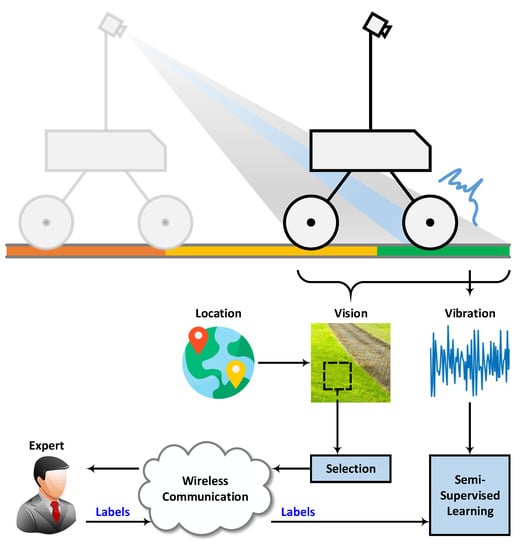
Figure 1.
Illustration of the terrain classification system.
Because a robot may be equipped with shock absorbers, the vibration sensors are preferred to be mounted on the axle. Hence, vibration data and the corresponding image of terrain patch could be matched. As terrain type is defined in terms of its appearance by a human, the robot could send the terrain images to a human and request labels. Field robots are designed to execute tasks in fields which are far from urban areas, and a field robot cannot guarantee reliable and fast communication, so it is impracticable for the robot to request all the manual labels. As a result, only a small portion of the terrain images are labelled manually, and a semi-supervised learning method will be employed to train the classifier after the labels arriving.
The problems is formulated as follows. A sample is denoted by . The work of terrain classification aims to classify the sample set into L subsets, where L is the number of terrain types. Under the semi-supervised learning framework, the robotic system requests ℓ samples to be labelled, and predicts the remaining unlabelled samples without any instructions from humans.
2.1. Feature Extraction
An accelerometer is employed to collect the z-axis acceleration sequences at 100 Hz. Actually, the detected acceleration do not only contain a pure motion-induced vibration, but also the gravitational acceleration. Because the robot works on horizontal ground, the gravity could be treated as a constant number, and therefore, subtracting the gravitational acceleration from the acceleration sequence could yield the vibration sequence. In addition, all vibration sequences are segmented into sub-sequences which are called vibration frames. Each vibration frame is composed of m successive vibration points, and overlaps its forward/backward vibration frames by 50% to guarantee the classification timeliness. Define a vibration frame by . Now we are in a position to extract features from a in the time domain and the frequency domain.
2.1.1. Frequency-Domain Features
Transforming the vibration sequence from the time domain to the frequency domain is usually very helpful, as it could extract discriminative signal components and simplify the mathematical analysis. As a frequently-used digital signal decomposition tool, the discrete Fourier transform (DFT) could output the amplitude spectrum of sequence in a time-discrete way. The -point DFT on the vibration frame a is defined by
where , and k is the frequency. In the paper, we use the fast Fourier transform (FFT) to implement DFT, thereby accelerating the signal decomposition. The parameter should be an integer which can be factored into a product of small prime numbers, or a power of 2, simply. If , the vibration frame a should be padded with zeros. In other words, the terms are set to zeros.
Our experiment employs an accelerometer with up to 100 Hz frequency. Because the terrain prediction is desired to be provided every second, i.e., terrain classification works at 1 Hz, we set . By using 128-point FFT, a 128-dimensional feature vector is obtained. In order to increase the classification speed and reduce redundancy features, we can sample some entries uniformly from the spectral vector to constitute the frequency-domain feature vector.
2.1.2. Time-Domain Features
Apart from extracting features in frequency domain, we can also extract features in the time domain directly. The existing literature has proposed many time-domain features and achieved an acceptable classification accuracy, but only a portion of them contribute primarily to the classification performance [24]. In this paper, the time-domain feature vector is shown as follows:
- : The number of sign variationswhere is an indicator function, which outputs 1 if the expression in holds, or 0 otherwise. This feature is an approximation of the frequency of a.
- : The mean of awhich measures the coarse degree of terrains. This feature may considerably diverge from zero for some coarse terrains.
- : The number of sign changes in whereThis is a complement to , which avoids for even a high-frequency vibration sequence when the robot is traversing coarse terrain.
- : The variance of aIntuitively, the variance is higher when the terrain becomes coarser.
- : The autocorrelation function of awhere is an integer indicating time difference. As a measure of non-randomness, gets larger with a stronger dependency between and . Obviously, this feature can be extended by setting . However, according to Khintchine’s law, it should be guaranteed that bounds the estimation error of . In the paper, we choose .
- : The maximum value in awhich indicates the biggest bump of the terrain.
- : The minimum value in awhich indicates the deepest puddle of the terrain.
- : The -norm of awhich reflects the energy of a. If , has the similar function as . Instead, we can also use the -norm; i.e.,
- : The impulse factor of awhich measures the impact degree in a.
- : The kurtosis of awhich measures the deviation degree of the a with Gaussian distribution.
2.2. Laplacian Support Vector Machine
The Laplacian SVM (LapSVM) uitised in this paper is an extension of the traditional support vector machine (SVM). It is worth noting that the LapSVM belongs to semi-supervised learning, which is different from SVM. The LapSVM trains the model from the labelled and unlabelled data according to the manifold assumption, while the SVM only uses the labelled data. Consequently, we will first introduce the SVM model, and then expatiate on the formulation of LapSVM, including the construction of similarity matrices in the remainder of this chapter.
2.2.1. SVM Model
The SVMs are a series of classification algorithms that divide data into two groups with a separating hyperplane. Considering the incompleteness of training data and the existence of the noise interferes, the separating hyperplane of maximum margin is applied in the SVMs to improve the robustness. Hence, the separating hyperplane can be represented as the following linear equation
where is a normal vector with respect to the hyperplane, b is a scalar bias deciding the distance from the origin to hyperplane and denotes the transpose. In general, the classification tasks are hardly completed in the data space when the samples cannot be classified linearly (e.g., Xor classification problems). Hence, the kernel function is introduced to SVM to map the samples from original data space to a high-dimensional space, where an adequate separating hyperplane could be found for the nonlinear classification problems. First, given the mapping function , the hyperplane in Equation (13) can be rewritten as:
According to the representer theorem proposed in [45], the kernel function is denoted by and the where , and thereby we have
where denotes the Lagrangian multiplier. The samples with determine the decision function; hence naming them support vectors.
2.2.2. Semi-Supervised Learning
As an extension of SVM, the LapSVM introduces a manifold regularisation term to improve the smoothness of model. By utilising the similarity among the labelled and unlabelled samples, the Laplacian matrix of the graph is created—Laplacian SVM [46]. The LapSVM is achieved by solving the following optimization problem,
where f denotes the decision function, denotes the labels, V denotes a given loss function, i.g., . The coefficients and control the complexity of f in the reproducing kernel Hilbert space (RKHS) and in the intrinsic geometry of the marginal distribution, respectively.
In Equation (16), the regularisation term can be expanded in terms of the expansion coefficients and kernel matrix as follows,
Similarly, the regularisation term in Equation (16) can be rewritten, which is based on the manifold assumption,
where is the similarity between the - and -th samples, thereby denoting the similarity matrix , . Define the Laplacian matrix of W by , where D denotes the degree matrix with element and denotes the -th element in W. The normalised form of L is . The construction of the similarity matrix W is introduced in the next section.
2.2.3. Similarity Matrix
As shown in Figure 2, we observe that samples of terrain types comply with the homogeneities both in the feature space and temporal dimension, which could be utilised to improve the classification performance under the lack of labels. The first similarity matrix is established based on the homogeneity in feature space. The -th element in is denoted by
where denotes the set of -nearest neighbouring samples of under the metric of euclidean distance in feature space, and denotes the width of Guassian kernel.
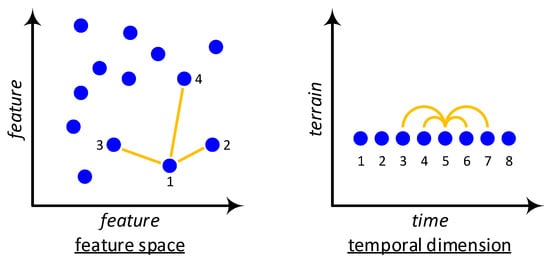
Figure 2.
Illustration of establishment of similarity matrix. As the left subfigure shows, and under . As the right subfigure shows, and under .
Analogously, the second similarity matrix is established based on the homogeneity in temporal dimension. The -th element in is denoted by
where is an even, and denotes the width of Guassian kernel.
The two similarity matrixes and can be merged into one similarity matrix W by
where denotes the weight and denotes a given nonlinear function. The weight coefficient selects which homogeneity is more convinced. For example, if terrain switches from one type to another more frequently over time, should be greater because of the weaker temporal correlation. The nonlinear function , e.g., , could increase the similarity between two samples which are similar both in feature space and temporal dimension.
2.2.4. Solution of LapSVM
According to Equations (17), (18) and (21), Equation (16) is rewritten as
the solution of which is the targeted SVM classification model. According to the representer theorem proposed in [45], the solution of Equation (22) can be found in RKHS and is expressed by
where denotes the kernel, and and is worked out by the preconditioned conjugate gradient (PCG) algorithm [46].
3. Experimental Verification
3.1. Experiment Setup
The experiment is conducted by a four-wheel mobile robot, the photo and electronic system of which are shown in Figure 3. The robot is 340 mm in length, 270 mm in width, 230 mm in height and 2.6 kg in mass. The diameter and width of the wheels are 130 mm and 60 mm, respectively. With a power supply of 12 V, the robot could traverse coarse ground at a speed of up to 1.5 m/s. The sensing system is composed of an accelerometer, gyroscope, magnetometer and odometer. The data collector reads the accelerometer and odometrer at 100 Hz and 1 Hz, respectively. All data is recorded in the onboard flash memory, and transferred to a computer (3.20 GHz, 8 GB RAM). Controlled by a smart phone via Bluetooth, the robot traverses six typical terrains. Photos of patches of terrains and the related vibration sub-sequences are shown in Figure 4. Some of them are artificial terrains (e.g., asphalt road), while some are natural ones (e.g., natural grass). These terrains are different in rigidity, roughness and flatness. Compared with other terrains, it is observed that the interaction between the robot and the cobble path generates a highly distinguishable vibration. The vibration has higher frequency, larger magnitude and weaker autocorrelation, because the cobble path is relatively rigid and irregular. The vibrations of the other five terrains may not be easy to discriminate intuitively; their slight differences, however, still can be found in terms of their variational tendencies. The dataset is composed of 1584 vibration frames belonging to six different terrains (natural grass (NG), asphalt road (AR), cobble path (CP), artificial grass (AG), sand beach (SB), plastic track (PT)), and each terrain has 264 frames.
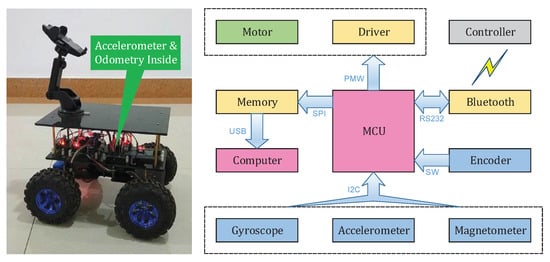
Figure 3.
The photograph and electronic system structure of the experimental four-wheeled mobile robot.
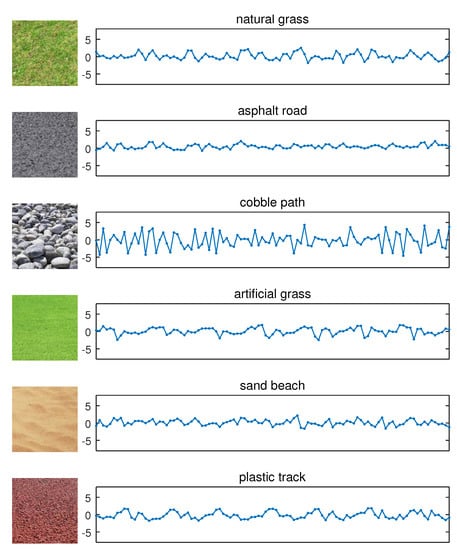
Figure 4.
Photos of patches of terrains and the related vibration sub-sequences. From top to bottom, they are: natural grass (NG), asphalt road (AR), cobble path (CP), artificial grass (AG), sand beach (SB), plastic track (PT), respectively. The Y axis represents acceleration (m/s).
3.2. Data Visualisation
We visualise our data through t-distributed stochastic neighbour embedding (t-SNE). As shown in [47], t-SNE is a non-linear technique for dimensionality reduction that is particularly well suited for the visualisation of high-dimensional datasets. The t-SNE minimises the divergence between two distributions: a distribution that measures pairwise similarities of the input objects and a distribution that measures pairwise similarities of the corresponding low-dimensional points in the embedding. The Kullback–Leibler (KL) divergence of the joint probability of the original space and the embedded space is used to evaluate the quality of visualisation effect. That is to say, the function of KL divergence is used as a loss function, and then the loss function is minimised by gradient descent, and finally the convergence result is obtained.
Figure 5 shows the t-SNE visualisation of the time-domain features and frequency-domain features of our data. It is easy to derive the following conclusions: (1) The data of CB do not intersect with and are far away from the other data; hence CB could be recognised easily and accurately. This is because CB is relatively rigid and irregular, and CB-induced vibration is distinguishable compared with other terrain types, which is also demonstrated in Figure 4. (2) The data of AR are relatively clustered and barely intersect with those of NG, AG, SB, PT, both in the time domain and frequency domain, so AR could be recognised with the second accuracy. (3) The data of terrains other than CB and AR may intersect with others more or less, so there may exist confusion in the classification of the four terrains. In particular, for NG and SB, the data are embedded into each other, so it is a challenge to distinguish them. (4) Compared with the time-domain features, the frequency-domain features have more clustered behaviour in the 2-dimensional feature space. It can be predicted that the frequency-domain features could yield a better classification accuracy.
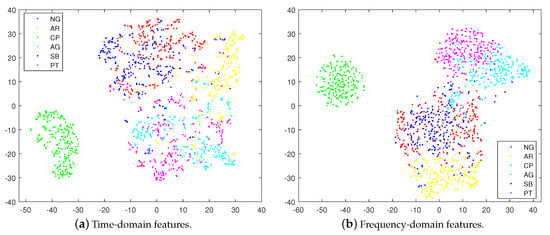
Figure 5.
The t-SNE visualisation of the feature representations of our data.
As shown in Figure 6, we split the terrain sequence into segments and concatenate them into a new rearranged terrain sequence. We use dwelling time to describe the terrain switching frequency. It is observed that the terrain sequence implicates temporal correlation; i.e., the next terrain has the same type as the current type very possibly. From top to bottom, each terrain dwells for 264, 66 or 22 sampling points, respectively. In the following experiment, we will show the influence of classification accuracy by different dwelling times.
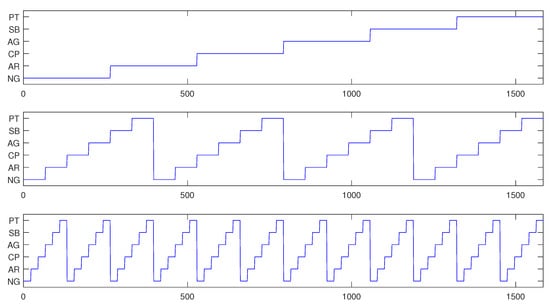
Figure 6.
Sampled terrain sequences with different dwelling times. From top to bottom, each terrain dwells for 264, 66 or 22 sampling points, respectively. X axis represents sampling point.
3.3. Experiment Coding
We will evaluate the classification performance by SVM, the traditional LapSVM (t-LapSVM), and the proposed LapSVM (p-LapSVM), all conducted by MATLAB. If using SVM, the labelled data are used to train the classifier. We use the famous tool “LIBSVM” to train a 6-class classifier and test it directly [48]. If using LapSVM, both the labelled and unlabelled data are used to train the classifier. These trained classifiers are tested on the unlabelled data. The tool of binary t-LapSVM [47] written in MATLAB has been released at http://www.dii.unisi.it/~melacci/lapsvmp/. Multi-class t-LapSVM is realised by one-versus-one strategy. The t-LapSVM only considers the homogeneity in the feature space, while the p-LapSVM considers the homogeneities in the feature space and the temporal dimension. Hence, we modify the t-LapSVM code through adding an extra similarity matrix coupled with its weight, thereby deriving the p-LapSVM tool. As for the other tools, those concerning machine learning could be easily realised by using the built-in functions of MATLAB.
3.4. Experiments on the Labelling Strategy 1 (LS1)
In this part, we randomly select the samples with equal number from each class, and label them. This is an ideal yet unrealisable labelling strategy, which is used to evaluate the effectiveness of the semi-supervised learning algorithm.
3.4.1. SVM
The experiment results using SVM under LS1 are shown in Figure 7. Using time-domain features and , the total classification accuracy is 75.64%. As Figure 7a illustrated, CP could be classified with 100% accuracy, while the other five terrains could not be classified with acceptable accuracies. It was found that there were obvious confusions between NG and SB; AG and PT; and SB and PT, which can be interpreted from Figure 5a. Adjusting from 10 to 100, the number of labelled data increased, but it is not easy to observe the increasing of classification accuracy, as shown in Figure 7c. Observe the performances in the frequency domain. The total classification accuracy is 82.19% under . The confusions between NG and SB; AG and PT; and SB and PT still exist, but the other confusions are reduced through observing the differences between Figure 7a and Figure 7b. With increasing, the classification accuracy is increased slightly, as shown in Figure 7d.

Figure 7.
Classification performance of SVM under Labelling Strategy 1 (LS1).
3.4.2. t-LapSVM
The experiment results of t-LapSVM under LS1 are shown in Figure 8. Using time-domain features and , the total classification accuracy is 76.21%, so the classification is almost not improved from SVM to t-LapSVM. Comparing Figure 8a with Figure 7a, it is observed that some confusions are weakened and some are strengthened. This is because the unlabelled data could be labelled correctly if the feature-space homogeneity holds; otherwise they may be labelled incorrectly. As Figure 5a shows, the data of different classes intersect partially; i.e., the feature-space homogeneity does not hold. Therefore, the data which could be correctly predicted by SVM may not be predicted correctly by t-LapSVM. Although increasing the number of labelled samples, the classification cannot be improved, which is observed by comparing Figure 8c with Figure 7c. The total classification accuracy using frequency-domain features is 78.85% under . Observing Figure 8b,d, it is found that the classification performs worse by introducing semi-supervised learning. Hence, inappropriate utilisation of unlabelled data may cause a deterioration in classification. In Table 1, we present the classification performances with different parameters of t-LapSVM. It was observed that changing the values of , , and did not cause a significant variation in classification performance, which may reveal that the assumption of feature-space homogeneity is invalid.
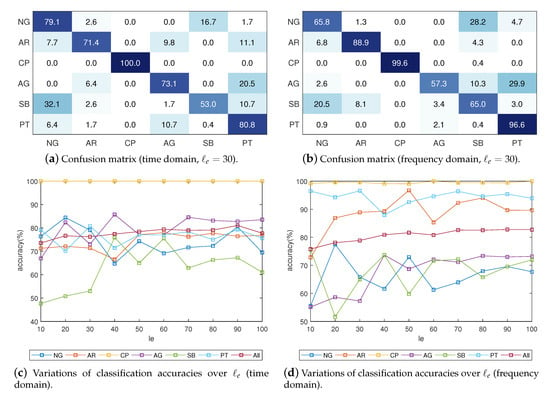
Figure 8.
Classification performance of t-LapSVM under LS1 (, , , ).

Table 1.
Classification performances under different parameters of t-LapSVM (time domain, ).
3.4.3. p-LapSVM
The experiment results of p-LapSVM under LS1 are shown in Figure 9. Using time-domain features and , the total classification accuracy is 90.95%, so the classification is increased by about 15% compared with t-LapSVM. Comparing Figure 9a with Figure 8a, it is clear that most confusions are weakened significantly. Additionally, as shown in Figure 9c, the total classification accuracy increases from 85% to 98% with ℓ increasing from 10 to 100. Table 2 lists the total classification accuracies under different parameters of p-LapSVM. It can be found that the total classification accuracy could even reach 99.64% if the parameters could be set appropriately. The parameter setting obeys the following rule: the homogeneity in temporal dimension should be weighted more under a large dwelling time (i.e., terrain switches infrequently); otherwise, weighted less under a small dwelling time (i.e., terrain switches frequently). As column 5 shows, and , meaning the homogeneity in temporal dimension receives the highest weight, so the total classification accuracy is extremely high under but extremely low under . Hence, the homogeneity in temporal dimension should be weighted moderately rather than exceedingly, especially in the situation in which cannot be determined. The experiment demonstrates that the p-LapSVM could properly utilise the homogeneity in temporal dimension, and thereby realise the terrain classification with high accuracy under the lack of labels. In the frequency domain, the total classification accuracy is 93.30% under , and the classification could be further improved with a larger .
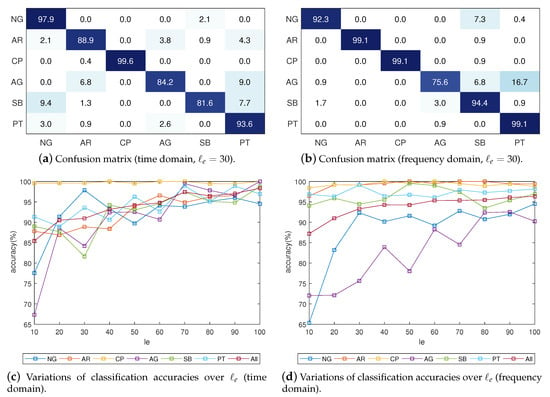
Figure 9.
Classification performance of p-LapSVM under LS1 and dwelling time (, , , , , , ).

Table 2.
Total classification accuracies under different parameters of p-LapSVM (time domain, , , , ).
3.5. Experiments on Labelling Strategy 2 (LS2)
The LS1 is not realizable in practice, so we try to employ another practicable labelling strategy. If the number of total labelling samples is set to , then we use -clustering algorithm to yield clusters and randomly select one sample from each cluster to request manual labelling. It is noted that . In this part, we aim to show the influence of class imbalance, which is caused by the labelling strategy, on the semi-supervised learning accuracy. As shown in Figure 10, the classes of the selected samples are not balanced, but not so seriously. The classification accuracies of p-LapSVM over under LS2 are shown in Figure 11 and Figure 12. It is easy to find that the total classification accuracy decreases under the same total number of labelled samples, for the presence of class imbalance. However, a significant improvement in accuracy can be still observed by using the modified LapSVM.
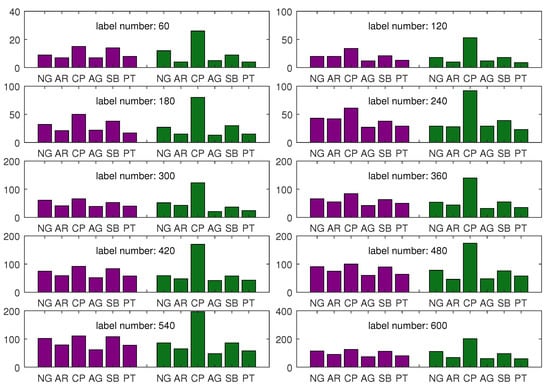
Figure 10.
Distribution over classes of labelled samples generated by LS2. Green bars stand for time domain and purple for frequency domain. Y axis represents the number of the sample.
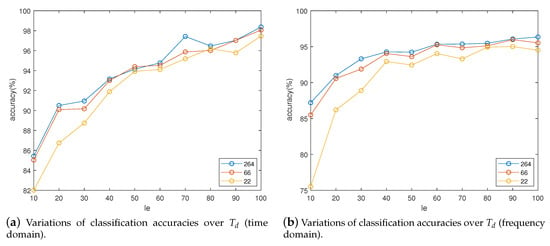
Figure 11.
Classification accuracies of p-LapSVM over under LS1 (, , , , , , ).
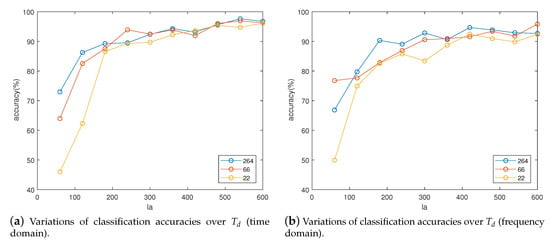
Figure 12.
Classification accuracies of p-LapSVM over under LS2 (, , , , , , ).
4. Conclusions
In the paper, the semi-supervised learning problem for terrain classification is investigated. To the best of our knowledge, such a semi-supervised learning problem has not been studied in robotic terrain classification. Based on the homogeneities in feature space and the temporal dimension, a modified Laplacian SVM is proposed, and thereby the intrinsic information of unlabelled data could be sufficiently used to increase the classification accuracy. As the experiment demonstrated, the modified Laplacian SVM overwhelms the traditional Laplacian SVM in accuracy.
Author Contributions
Conceptualisation, W.L.; data curation, Z.L.; formal analysis, J.C.; funding acquisition, W.L.; investigation, Z.L.; methodology, W.S.; software, J.C.; supervision, W.L.; visualisation, Y.W.; writing—original draft, W.S. and W.L.; writing—review and editing, Y.W. and X.L. All authors have read and agreed to the published version of the manuscript.
Funding
This work was supported in part by the National Natural Science Foundation of China (61903353), SINOPEC Programmes for Science and Technology Development (PE19008-8) and the Fundamental Research Funds for the Central Universities.
Conflicts of Interest
The authors declare no conflict of interest.
References
- Siegwart, R.; Nourbakhsh, I.R.; Scaramuzza, D. Introduction to Autonomous Mobile Robots; MIT Press: Cambridge, MA, USA, 2011. [Google Scholar]
- Wang, C.; Lv, W.; Li, X.; Mei, M. Terrain Adaptive Estimation of Instantaneous Centres of Rotation for Tracked Robots. Complexity 2018, 2018, 1–10. [Google Scholar] [CrossRef]
- Ramasamy, S.; Sabatini, R.; Gardi, A.; Liu, J. LIDAR obstacle warning and avoidance system for unmanned aerial vehicle sense-and-avoid. Aerosp. Sci. Technol. 2016, 55, 344–358. [Google Scholar] [CrossRef]
- Spiteri, C.; Al-Milli, S.; Gao, Y.; de León, A.S. Real-time visual sinkage detection for planetary rovers. Robot. Auton. Syst. 2015, 72, 307–317. [Google Scholar] [CrossRef]
- Li, Y.; Ding, L.; Liu, G. Error-tolerant switched robust extended Kalman filter with application to parameter estimation of wheel-soil interaction. IEEE Trans. Control. Syst. Technol. 2014, 22, 1448–1460. [Google Scholar]
- Lv, W.; Kang, Y.; Zhao, Y.B. FVC: A Novel Nonmagnetic Compass. IEEE Trans. Ind. Electron. 2018, 66, 7810–7820. [Google Scholar] [CrossRef]
- Chen, M. Disturbance attenuation tracking control for wheeled mobile robots with skidding and slipping. IEEE Trans. Ind. Electron. 2016, 64, 3359–3368. [Google Scholar] [CrossRef]
- Pentzer, J.; Brennan, S.; Reichard, K. On-line estimation of vehicle motion and power model parameters for skid-steer robot energy use prediction. In Proceedings of the American Control Conference, Portland, OR, USA, 4–6 June 2014; pp. 2786–2791. [Google Scholar]
- Reinstein, M.; Kubelka, V.; Zimmermann, K. Terrain adaptive odometry for mobile skid-steer robots. In Proceedings of the IEEE International Conference on Robotics and Automation, Karlsruhe, Germany, 6–10 May 2013; pp. 4706–4711. [Google Scholar]
- Lv, W.; Kang, Y.; Qin, J. Indoor localization for skid-steering mobile robot by fusing encoder, gyroscope, and magnetometer. IEEE Trans. Syst. Man Cybern. Syst. 2017, 49, 1241–1253. [Google Scholar] [CrossRef]
- Reina, G.; Ishigami, G.; Nagatani, K.; Yoshida, K. Odometry correction using visual slip angle estimation for planetary exploration rovers. Adv. Robot. 2010, 24, 359–385. [Google Scholar] [CrossRef]
- Khan, Y.N.; Komma, P.; Bohlmann, K.; Zell, A. Grid-based visual terrain classification for outdoor robots using local features. In Proceedings of the Symposium on Computational Intelligence in Vehicles and Transportation Systems, Paris, France, 11–15 April 2011; pp. 16–22. [Google Scholar]
- Khan, Y.N.; Komma, P.; Zell, A. High resolution visual terrain classification for outdoor robots. In Proceedings of the IEEE International Conference on Computer Vision, Barcelona, Spain, 6–13 November 2011; pp. 1014–1021. [Google Scholar]
- Khan, Y.N.; Masselli, A.; Zell, A. Visual terrain classification by flying robots. In Proceedings of the IEEE International Conference on Robotics and Automation, St. Paul, MN, USA, 14–18 May 2012; pp. 498–503. [Google Scholar]
- Filitchkin, P.; Byl, K. Feature-based terrain classification for littledog. In Proceedings of the IEEE/RSJ International Conference on Intelligent Robots and Systems, Vilamoura, Portugal, 7–12 October 2012; pp. 1387–1392. [Google Scholar]
- Wu, H.; Liu, B.; Su, W.; Chen, Z.; Zhang, W.; Ren, X.; Sun, J. Optimum pipeline for visual terrain classification using improved bag of visual words and fusion methods. J. Sens. 2017, 2017, 1–25. [Google Scholar] [CrossRef]
- Zou, Y.; Chen, W.; Xie, L.; Wu, X. Comparison of different approaches to visual terrain classification for outdoor mobile robots. Pattern Recognit. Lett. 2014, 38, 54–62. [Google Scholar] [CrossRef]
- Gonzalez, R.; Rituerto, A.; Guerrero, J. Improving robot mobility by combining downward-looking and frontal cameras. Robotics 2016, 5, 25. [Google Scholar] [CrossRef]
- Wellhausen, L.; Dosovitskiy, A.; Ranftl, R.; Walas, K.; Cadena, C.; Hutter, M. Where should i walk? Predicting terrain properties from images via self-supervised learning. IEEE Robot. Autom. Lett. 2019, 4, 1509–1516. [Google Scholar] [CrossRef]
- Anantrasirichai, N.; Burn, J.; Bull, D. Terrain classification from body-mounted cameras during human locomotion. IEEE Trans. Cybern. 2014, 45, 2249–2260. [Google Scholar] [CrossRef] [PubMed]
- Zhu, Y.; Luo, K.; Ma, C.; Liu, Q.; Jin, B. Superpixel segmentation based synthetic classifications with clear boundary information for a legged robot. Sensors 2018, 18, 2808. [Google Scholar] [CrossRef]
- Kertész, C. Rigidity-based surface recognition for a domestic legged robot. IEEE Robot. Autom. Lett. 2016, 1, 309–315. [Google Scholar] [CrossRef]
- Yu, H.; Lee, B.H. A Bayesian approach to terrain map inference based on vibration features. In Proceedings of the International Conference on Multisensor Fusion and Integration for Intelligent Systems (MFI), Daegu, Korea, 16–18 November 2017; pp. 272–277. [Google Scholar]
- Hoepflinger, M.A.; Remy, C.D.; Hutter, M.; Spinello, L.; Siegwart, R. Haptic terrain classification for legged robots. In Proceedings of the IEEE International Conference on Robotics and Automation, Sydney, Australia, 3–7 December 2010; pp. 2828–2833. [Google Scholar]
- Best, G.; Moghadam, P.; Kottege, N.; Kleeman, L. Terrain classification using a hexapod robot. In Proceedings of the Australasian Conference on Robotics and Automation, Sydney, Australia, 2–4 December 2013. [Google Scholar]
- Oliveira, L.F.P.; Rossini, F.L. Modeling, simulation and analysis of locomotion patterns for hexapod robots. IEEE Lat. Am. Trans. 2018, 16, 375–383. [Google Scholar] [CrossRef]
- Wu, X.A.; Huh, T.M.; Mukherjee, R.; Cutkosky, M. Integrated ground reaction force sensing and terrain classification for small legged robots. IEEE Robot. Autom. Lett. 2016, 1, 1125–1132. [Google Scholar] [CrossRef]
- Kolvenbach, H.; Bärtschi, C.; Wellhausen, L.; Grandia, R.; Hutter, M. Haptic inspection of planetary soils with legged robots. IEEE Robot. Autom. Lett. 2019, 4, 1626–1632. [Google Scholar] [CrossRef]
- Walas, K.; Kanoulas, D.; Kryczka, P. Terrain classification and locomotion parameters adaptation for humanoid robots using force/torque sensing. In Proceedings of the IEEE International Conference on Humanoid Robots, Cancun, Mexico, 15–17 November 2016; pp. 133–140. [Google Scholar]
- Iagnemma, K.D.; Dubowsky, S. Terrain estimation for high-speed rough-terrain autonomous vehicle navigation. In Proceedings of the SPIE Unmanned Ground Vehicle Technology IV, Orlando, FL, USA, 1–5 April 2002; Volume 4715, pp. 256–266. [Google Scholar]
- Weiss, C.; Frohlich, H.; Zell, A. Vibration-based terrain classification using support vector machines. In Proceedings of the IEEE/RSJ International Conference on Intelligent Robots and Systems, Daejeon, Korea, 9–14 October 2016; pp. 4429–4434. [Google Scholar]
- Brooks, C.A.; Iagnemma, K. Vibration-based terrain classification for planetary exploration rovers. IEEE Trans. Robot. 2005, 21, 1185–1191. [Google Scholar] [CrossRef]
- Weiss, C.; Fechner, N.; Stark, M.; Zell, A. Comparison of Different Approaches to Vibration-based Terrain Classification. In Proceedings of the European Conference on Mobile Robots, Paris, France, 6–8 September 2017. [Google Scholar]
- Bermudez, F.L.G.; Julian, R.C.; Haldane, D.W.; Abbeel, P.; Fearing, R.S. Performance analysis and terrain classification for a legged robot over rough terrain. In Proceedings of the IEEE/RSJ International Conference on Intelligent Robots and Systems, Vilamoura, Portugal, 7–12 October 2012; pp. 513–519. [Google Scholar]
- Wang, S.; Kodagoda, S.; Shi, L.; Wang, H. Road-terrain classification for land vehicles: Employing an acceleration-based approach. IEEE Veh. Technol. Mag. 2017, 12, 34–41. [Google Scholar] [CrossRef]
- Komma, P.; Weiss, C.; Zell, A. Adaptive bayesian filtering for vibration-based terrain classification. In Proceedings of the IEEE International Conference on Robotics and Automation, Kobe, Japan, 12–17 May 2009; pp. 3307–3313. [Google Scholar]
- Komma, P.; Zell, A. Markov random field-based clustering of vibration data. In Proceedings of the IEEE/RSJ International Conference on Intelligent Robots and Systems, Taipei, Taiwan, 18–22 October 2010; pp. 1902–1908. [Google Scholar]
- Weiss, C.; Tamimi, H.; Zell, A. A combination of vision-and vibration-based terrain classification. In Proceedings of the IEEE/RSJ International Conference on Intelligent Robots and Systems, Madrid, Spain, 1–5 October 2018; pp. 2204–2209. [Google Scholar]
- Otsu, K.; Ono, M.; Fuchs, T.J.; Baldwin, I.; Kubota, T. Autonomous terrain classification with co-and self-training approach. IEEE Robot. Autom. Lett. 2016, 1, 814–819. [Google Scholar] [CrossRef]
- Bai, C.; Guo, J.; Zheng, H. Three-Dimensional Vibration-Based Terrain Classification for Mobile Robots. IEEE Access 2019, 7, 63485–63492. [Google Scholar] [CrossRef]
- Bai, C.; Guo, J.; Guo, L.; Song, J. Deep Multi-Layer Perception Based Terrain Classification for Planetary Exploration Rovers. Sensors 2019, 19, 3102. [Google Scholar] [CrossRef] [PubMed]
- Otte, S.; Weiss, C.; Scherer, T.; Zell, A. Recurrent Neural Networks for fast and robust vibration-based ground classification on mobile robots. In Proceedings of the IEEE International Conference on Robotics and Automation, Stockholm, Sweden, 16–21 May 2016; pp. 5603–5608. [Google Scholar]
- Kurban, T.; Beşdok, E. A comparison of RBF neural network training algorithms for inertial sensor based terrain classification. Sensors 2009, 9, 6312–6329. [Google Scholar] [CrossRef] [PubMed]
- Mei, M.; Chang, J.; Li, Y.; Li, Z.; Li, X.; Lv, W. Comparative Study of Different Methods in Vibration-Based Terrain Classification for Wheeled Robots with Shock Absorbers. Sensors 2019, 19, 1137. [Google Scholar] [CrossRef]
- Tikhonov, A.N. Regularization of incorrectly posed problems. Numer. Funct. Anal. Optim. 1963, 21, 1624–1627. [Google Scholar]
- Melacci, S.; Belkin, M. Laplacian Support Vector Machines Trained in the Primal. J. Mach. Learn. Res. 2011, 12, 1149–1184. [Google Scholar]
- Maaten, L.V.D.; Hinton, G. Visualizing data using t-SNE. J. Mach. Learn. Res. 2008, 9, 2579–2605. [Google Scholar]
- Chang, C.C.; Lin, C.J. LIBSVM: A library for support vector machines. ACM Trans. Intell. Syst. Technol. 2011, 2, 1–27. [Google Scholar] [CrossRef]
© 2020 by the authors. Licensee MDPI, Basel, Switzerland. This article is an open access article distributed under the terms and conditions of the Creative Commons Attribution (CC BY) license (http://creativecommons.org/licenses/by/4.0/).